Key takeaways:
- Gender equality advocacy requires understanding intersectionality and amplifying marginalized voices to create a multifaceted movement.
- Post-trauma identity exploration involves reconnecting with one’s passions, expressing emotions creatively, and seeking community support.
- Sharing personal stories fosters solidarity and encourages others to speak out, highlighting the transformative power of vulnerability.
- Building supportive communities involves intentional listening, celebrating each other’s journeys, and recognizing vulnerability as strength.
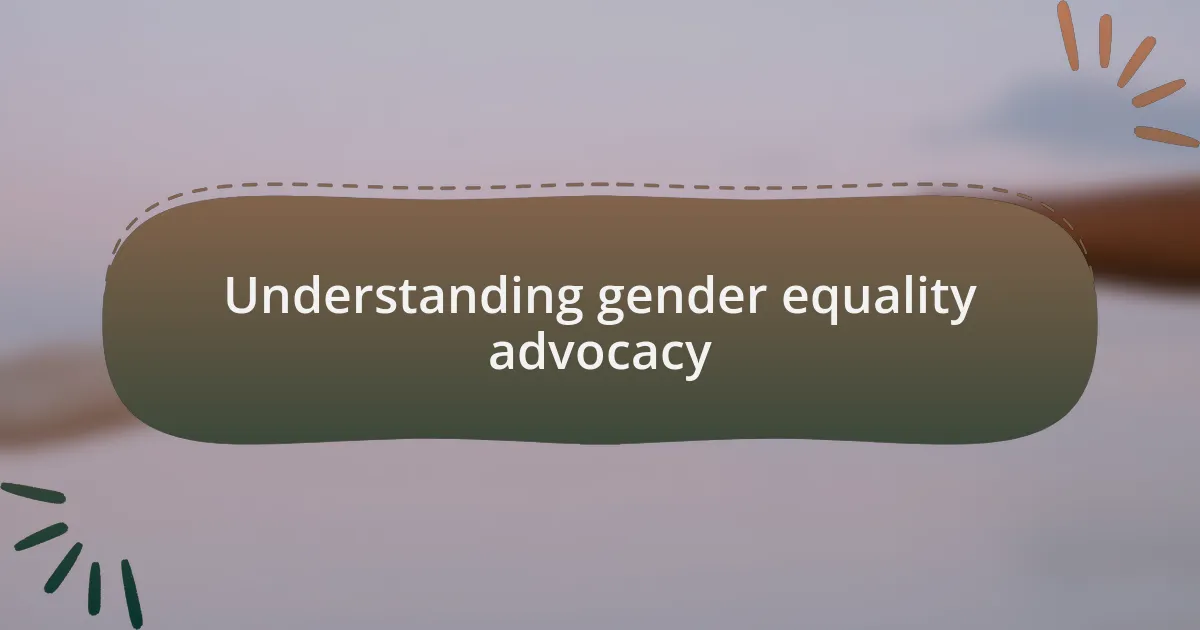
Understanding gender equality advocacy
Gender equality advocacy is about ensuring that everyone—regardless of gender—has equal rights, opportunities, and access to resources. I remember attending a community meeting where a speaker shared her journey. She articulated how legal barriers had held her back, and it struck me deeply. What does it feel like to have potential stifled by systemic issues? It makes one realize that advocating for gender equality isn’t just a lofty goal; it resonates with the lived experiences of many.
Understanding gender equality also requires recognizing the intersectionality of various identities—how race, class, and sexuality intertwine with gender. I once worked on a project that illuminated the struggles of women from marginalized communities. Hearing their stories enriched my perspective and filled me with a sense of urgency. How can we truly call for equality if we ignore these intricate layers? This awareness is vital; it transforms advocacy from a singular focus into a multifaceted movement.
Moreover, effective advocacy often begins with listening and amplifying voices that are frequently overlooked. I recall a workshop where we practiced active listening; the insights I gained from simply paying attention were invaluable. Wouldn’t it be transformative if we all approached advocacy with the intent to hear rather than speak? It taught me that advocacy isn’t just about promoting ideas; it’s about nurturing a community where everyone feels valued and empowered to share their experiences.
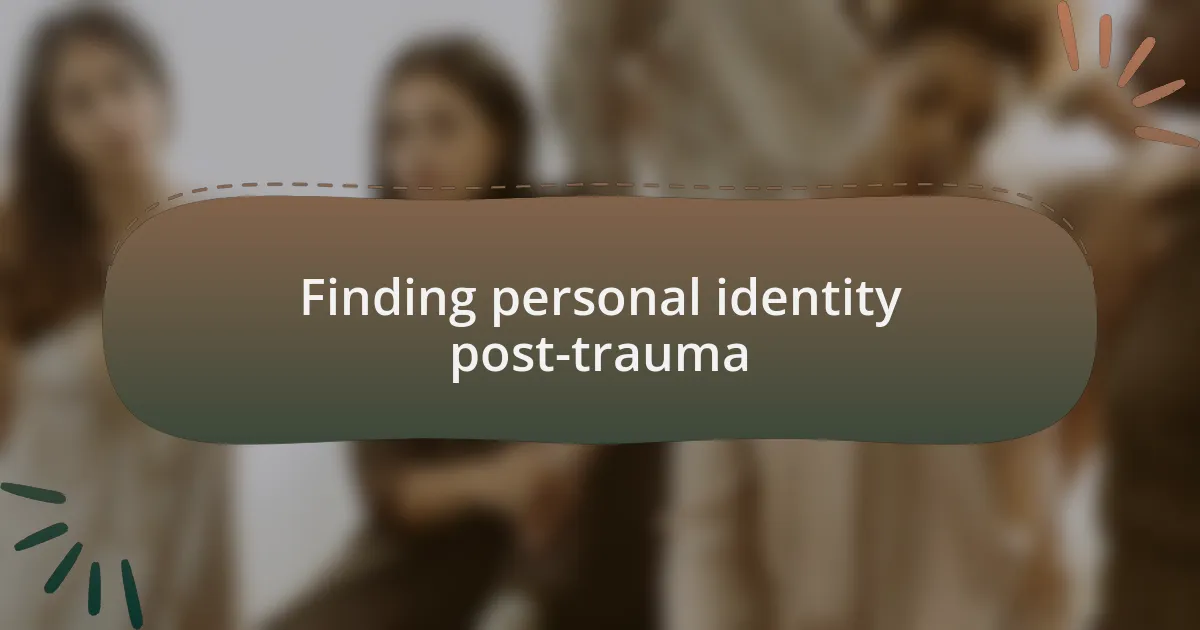
Finding personal identity post-trauma
Finding personal identity after trauma can feel like navigating a foggy landscape, where everything familiar is obscured. I remember standing in front of a mirror, trying to reconcile the person I once was with the emotional scars I carried. Who am I, now that I’ve faced something so shattering? That question lingered, prompting a deep dive into my values, beliefs, and the core of my identity.
I discovered that reclaiming my voice didn’t just involve addressing the trauma itself; it meant exploring the passions and interests that ignited joy within me. One day, I stumbled upon an old notebook filled with poetry I had written in happier times. Reading those lines felt like rediscovering a part of myself that I thought was lost forever. How can the act of creation serve as a powerful tool for healing? It’s clear to me now that sharing my story not only fosters personal growth but also encourages others to connect with their journeys.
In this exploration, I learned the importance of community. I sought support groups, engaging with others who understood my struggles. Their stories mirrored mine, creating a sense of belonging that was both comforting and empowering. Isn’t it incredible how connection can help us redefine who we are? In those shared moments, I began to see that my identity post-trauma could be rebuilt on a foundation of resilience, empathy, and shared experience.
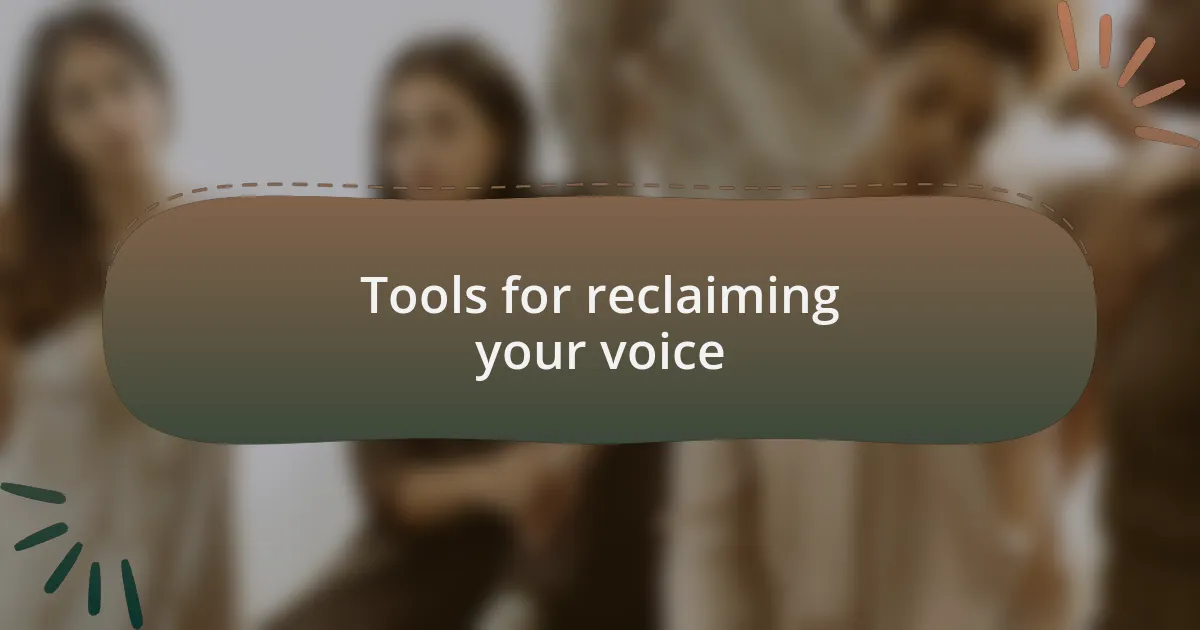
Tools for reclaiming your voice
Tools for reclaiming your voice are deeply personal and can vary significantly from one person to another. For me, journaling became an anchor. Each night, I spilled my emotions onto the pages, unearthing feelings I had buried. As I wrote, I often found solace in a simple question: What do I want to express today? That act of writing transformed into reclaiming my thoughts and feelings, allowing me to articulate my truth in a safe space.
Artistic expression was another powerful tool I discovered during my journey. After trauma, I felt disconnected from my creative self, yet painting became my refuge. I remember one evening, covered in paint and lost in the process, realizing that there were no rules—just colors and emotions flowing freely. Isn’t it liberating to create without limitations? This exploration led me to find my voice outside conventional boundaries, allowing me to express my narrative visually.
Lastly, practicing mindfulness turned out to be crucial in reframing my inner dialogue. Meditation sessions helped me tune into my body and feelings without judgment. I often reflected on the simple mantra, “I have a voice, and my voice matters.” This affirmation became a lifeline, reminding me that silence was no longer an option. By cultivating patience and self-compassion, I forged a deeper connection with my voice, transforming fear into empowerment.
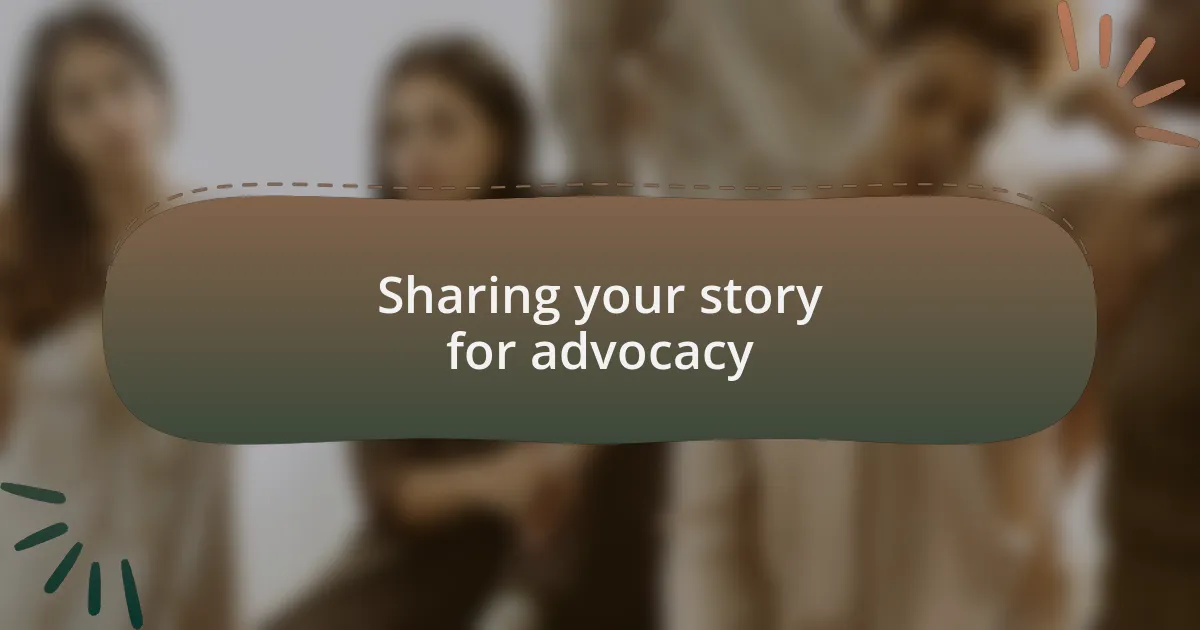
Sharing your story for advocacy
Sharing your story can be an incredibly powerful act of advocacy. I recall the first time I opened up about my experiences in a support group; it felt like peeling away the layers of a protective shell. Listening to others share their journeys made me realize that my voice held value, too. Have you ever felt that rush of connection when someone else’s experience mirrors your own? It’s transformative.
In my advocacy work, sharing my story has often sparked conversations I never anticipated. I remember writing a blog post detailing my recovery journey. The flood of messages from readers—some thanking me for speaking out, others sharing their own experiences—was overwhelming. It confirmed what I long suspected: vulnerability can breed solidarity and empathy. Isn’t it amazing how one honest account can create a ripple effect that inspires others to find the courage to speak up?
Each time I engage in storytelling for advocacy, I aim to create a safe space where people feel understood and validated. I’ve found that weaving personal anecdotes into discussions about gender equality strengthens the message. When people can relate to a narrative, it ignites emotions and promotes action. As I reflect on my journey, I wonder, what if every story shared ignites a movement? The potential is limitless.
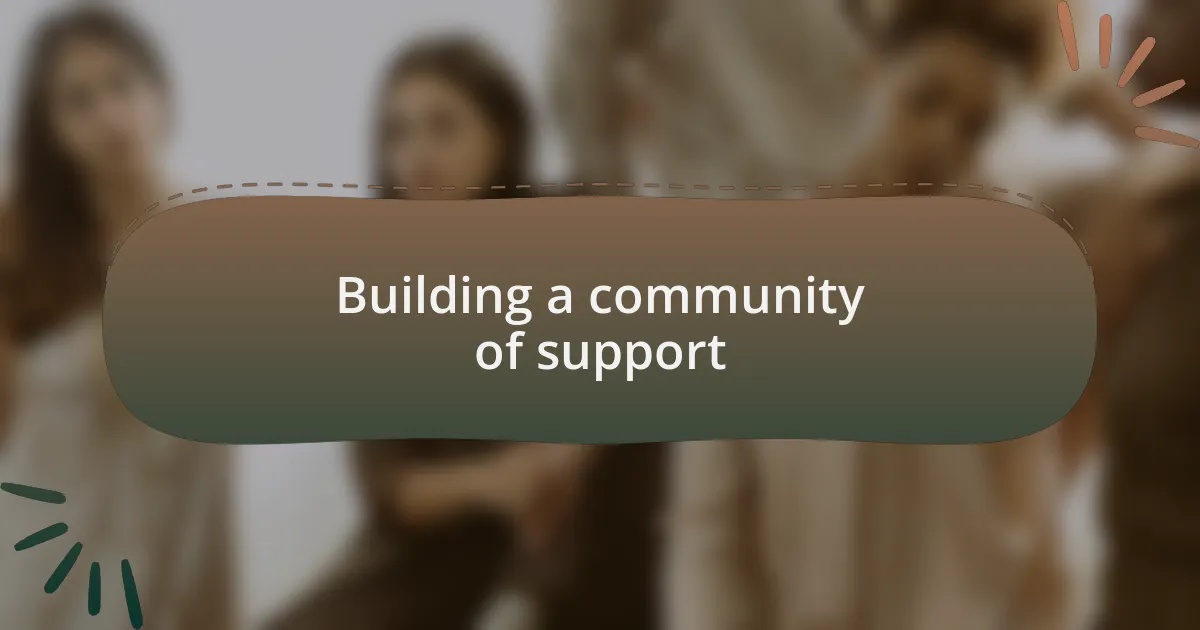
Building a community of support
Building a community of support requires intentional effort and authenticity. I remember the warmth I felt when I joined a local women’s group where we simply gathered to share our stories and support one another. It wasn’t just about discussing our struggles; it was about celebrating our victories, no matter how small. Have you ever experienced that moment when a stranger becomes a confidant, creating a sense of belonging that transcends isolation?
As we shared our journeys, there was this unspoken agreement that vulnerability was a strength, not a weakness. I vividly recall one evening when a member revealed her darkest moments. The collective intake of breath in the room was palpable, followed by an outpouring of support. It highlighted how crucial it is to create spaces where individuals feel safe to express their truths. Isn’t it remarkable how a single moment of openness can forge unbreakable bonds?
Building a community means actively listening and being present for one another. I’ve noticed that when I offer my support, it often leads others to step up, creating a reciprocal environment of encouragement. I often think, how can we not uplift each other in the face of adversity? This interconnectedness fosters resilience and empowerment, showing us that we are far stronger together than we are alone.
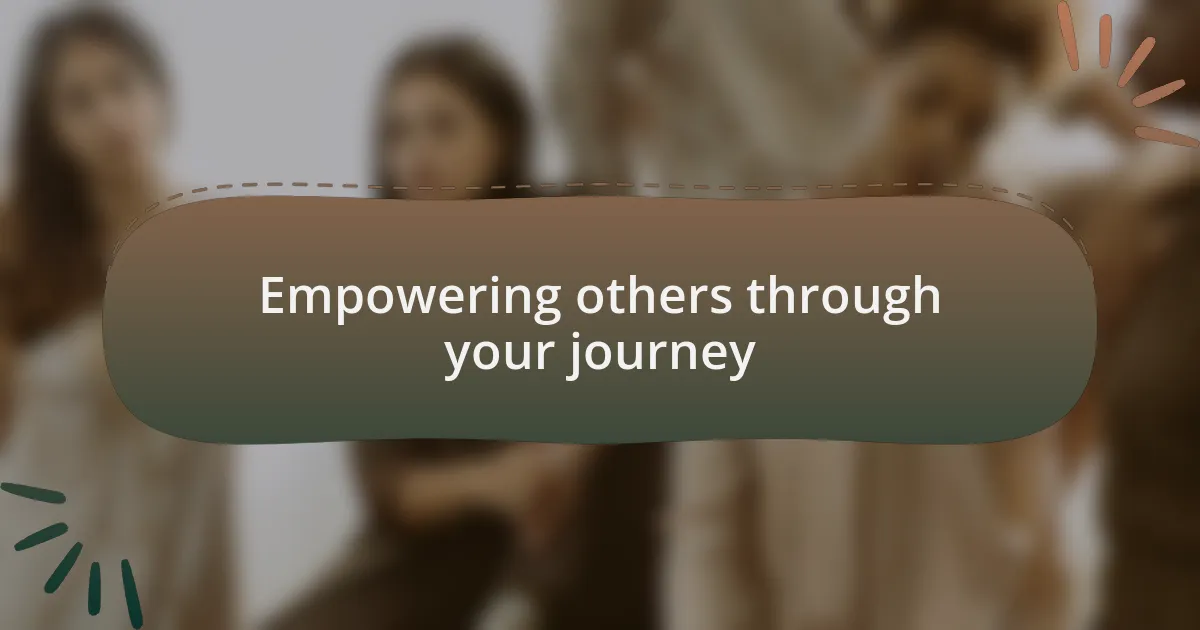
Empowering others through your journey
Empowering others through your journey is about sharing your truth with the hope of lighting a path for someone else. I once met a woman who, after hearing my story of resilience, found the courage to share her own trauma. It hit me then that this exchange wasn’t just about me; it was a reminder that our narratives can serve as beacons of hope, encouraging others to embark on their journeys toward healing.
Every time I recount my experiences, I watch as people lean in, intrigued and encouraged. I remember one particular encounter where I spoke at a community event. Afterward, a young woman approached me, tears in her eyes, saying that my words made her feel seen for the first time. It made me realize how vital it is to use our voices; they can foster connections and validation that someone desperately needs. Isn’t it powerful to think that sharing our stories can activate the healing journey in another?
As I reflect on my own path, I understand that empowerment can ripple outwards. I’ve seen how one person’s courage can inspire a chain reaction, prompting others to find and use their voices. Just last month, a friend told me that my advocacy encouraged her to start her own project focused on mental health awareness. How can we not harness the strength within our stories to uplift those around us? Together, we have the potential to create a culture of empowerment where everyone feels valued and seen.